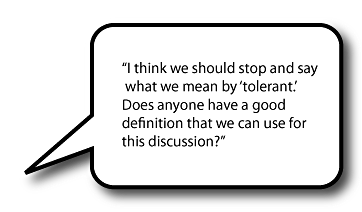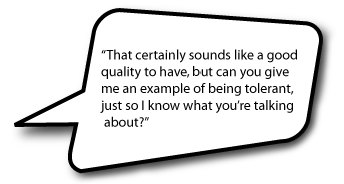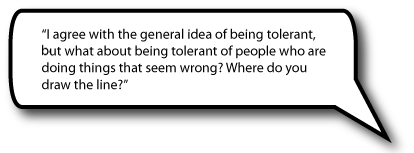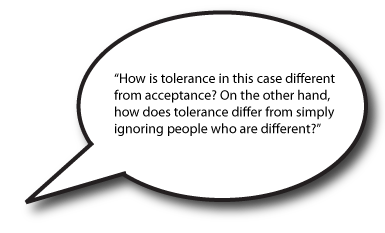Exploring a Topic

Five people get together to discuss the role of tolerance in a
good life.
The first person says, “I think that everyone who wants to lead a good life has to be tolerant.”
The second person says, “I think you are right.”
The third person says, “I don’t see how anyone would disagree with that.”
The fourth person says, “In my own life, I’ve found what you say to be true.”
The final person says, “This has been a great discussion.”
This was, of course, not a good discussion at all. It was a terrible discussion.
Why?
Nobody explored the topic.
Agreement is often not the reason we enter into a discussion. Sometimes it’s better to avoid agreement if it involves too much compromise. When people compromise, they each give up a little so the group can form a unified position on the topic. Compromise is nice in business and politics but need not be a part of an academic discussion.
The purpose of academic discussion is to uncover as many aspects of a topic as possible and to include as many reasonable points of view as possible. To put it another way, the purpose of a discussion is to keep the conversation going in a reasonable way. Differences in how people approach a topic are what make a discussion useful.
Let’s think about how the discussion at the beginning of this section could be improved. What if the second person had responded differently and said the following?:
“I think that everyone who wants to lead a good life has to be tolerant of people who are different.”
- Now, read a different response by the third person. Decide if it's a good response to the one above and a good contribution to the discussion. Would the response help to explore the topic, expand the discussion, and open up new possibilities? When you have an answer in mind, check your understanding.
- Here's another possible response to the second speaker. Again, would the response help to explore the topic, expand the discussion, and open up new possibilities? When you have an answer in mind, check your understanding.
- Let’s look at another response to “I think that everyone who wants to lead a good life has to be tolerant of people who are different.”
- What about this response to the second speaker? Is it a useful response to “I think that everyone who wants to lead a good life has to be tolerant of people who are different”?
Third person’s response:

Sample Response:
1. This is a superb comment. Notice that the speaker asks for a definition but that he or she does not ask someone to look up the word in the dictionary (though if the topic had contained an uncommon word, a dictionary definition might have been helpful). The definition for “tolerant” may not need to conform to definitions in other contexts, but the people in the discussion must agree on the term within the discussion.
CloseThird person’s response:

Sample Response:
2. This is a good reply. Notice that the speaker is polite. Discussion is not fighting. Also, notice that the speaker asks for more information from the person who spoke first. In a discussion, each speaker requests as much input as he or she contributes. Good discussions require give-and-take. They are based on mutual interest, and interest leads you to find out what you don’t already know. It’s hard to be interested in something if you have already made up your mind about it.
CloseThird person’s response:

Sample Response:
3. This is another superb comment. Notice that the speaker states some agreement. This makes it easier for others to hear the disagreement that comes next. Also notice that the speaker is polite. (The speaker could have said, “Are you crazy? Are we supposed to be tolerant of violent criminals?”) Finally, notice that the speaker asks others to consider the question rather than demanding an up or down vote. “Where do we draw the line?” invites further discussion.
CloseThird person’s response:

Sample Response:
4. This is an excellent comment. Notice that the speaker brings some new elements into play. The speaker introduces some contrasting attitudes which can be used to bring tolerance into sharper focus.
CloseIf we look over these comments, we find that several key attitudes are valuable in discussions:
- Be polite. Don’t start a fight.
- Ask for more information. Be interested.
- Focus on the main terms in the topic. Ask for agreement on definitions.
- Bring in new elements to challenge assumptions and reveal inconsistencies.
- Pursue the conversation with an open mind. Do not make moves that halt the conversation.